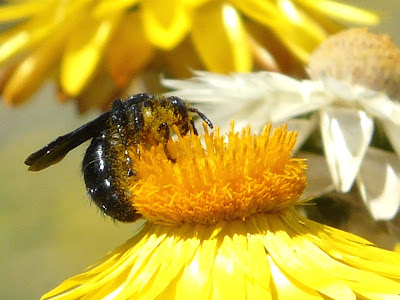Last month I foreshadowed an occasional series on colours, starting with white. It seems logical that the next instalment should be white's opposite - black. While white is produced when all wavelengths are reflected, a black surface is one that absorbs all light; when essentially no visible light from a particular source reaches our eye, our brain says 'black'. This is achieved by particular combinations of primary colours, or by black pigments. In nature, dark colours - blacks, greys, browns - are generally formed by varying concentrations of a family of chemical pigments called melanins, and particularly eumelanins.
There are various reasons for being black. Dark surfaces absorb heat, which may be valuable to 'cold-blooded' animals in particular. Melanins are valuable in protecting against ultra-violet light, having the chemical ability to convert UV radiation energy into heat. Melanins also provide resistance to wear in feathers, so wing tips of soaring birds are often black.
 |
| Black Crowned Cranes Balearica pavonina, Waza National Park, northern Cameroon. The wear-resistant black tips to the flight feathers are obvious. |
In combination with other colours - especially white, red or yellow - it can be very conspicuous, and form a warning pattern, or can help in breaking up a body outline and provide camouflage! This last aspect, of 'black in combination', we'll turn to on Wednesday. Today, just black... (Though having said that, it will be noticeable that in many of the following examples, there will be contrasting colours in other body parts.)
 |
| Black Vulture Coragyps atratus, Isla de Chiloé, Chile. Perhaps black helps soaring birds keep warm at high altitudes? |
 |
| African Black Crake Amaurornis flavirostra, Queen Elizabeth National Park, Uganda. |
| Sooty Oystercatcher Haematopus fuliginosus, Murramarang NP, south coast New South Wales. Though similar to black oystercatchers elsewhere in the world, this one is endemic to Australia. |
 |
| Dragonfly, Murchison Falls NP, Uganda. Sorry, no further information! |
.jpg) |
| Native Bee on paper daisy, Xerochrysum, Canberra. |
 |
| Sun Bear Helarctos malayanus, Perth Zoo (sorry, it was the only one I have!) Aberrant melanistic forms aside (eg black leopards or jaguars) there are not many black mammals. |
 |
| Mountain Gorilla Gorilla beringei beringei, Bwindi Impenetrable National Park, Uganda. |
 |
| Black Kangaroo Paw, Macropidia fuliginosa, Lesueur NP, Western Australia. Not many black flowers to choose from, hence this ancient and faded slide; sorry! |
 |
| Tarantula (under the seat we were napping on!), Blanquillo Lodge, Peruvian Amazonia. Oddly, as far as I can determine, spiders don't have melanins! |
Back Wednesday, with some black-and-coloureds.


